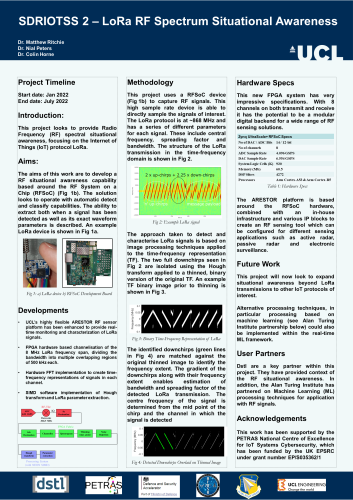SDRIOTSS 2
AIM
The SDRIOTSS-2 project aims to develop directly from the previous funded PETRAS SDRIOTSS project an operational live technology demonstrator system that can provide real time spectrum situational awareness of IoT devices. Collaborations with the project partners (Dstl and the Alan Turing Institute (ATI)) will provide both real world scenarios and end user feedback, as well as mentoring, on machine learning RF applications.
WHY
IoT signals are used extensively in urban and increasingly military scenarios. Yet, due to their recent uptake, they are often not being sensed by traditional Electronic Support systems and hence the awareness of their presence is a capability gap. The ability to sense these signals will provide vital situation awareness.
HOW
While the previous SDRIOTSS project proved it was possible to detect and classify IoT signals, focusing on the LoRa IoT protocol, with advanced FPGA+RF hardware, this SDRIOTSS-2 project looks to increase the TRL level of this concept and create a real-time system, which can automatically detect and classify the presence of signals of interest in real world scenarios. The project aims to satisfy the “knowledge into practice” requirements of the PETRAS ISPEF funding call in two main regards. Firstly, it proposes to take code or devices developed under the SDRIOTSS project from the lab and increase their TRL to the level of a technology-demonstrator system. Secondly, it will develop IP that looks to produce optimum signal processing methods for detecting and classifying IoT RF signals using cutting edge FPGA and RF hardware.
The SDRIOTSS-2 poster displayed at the PETRAS Academic Conference | Networking Research Showcase on 16 June 2022:


